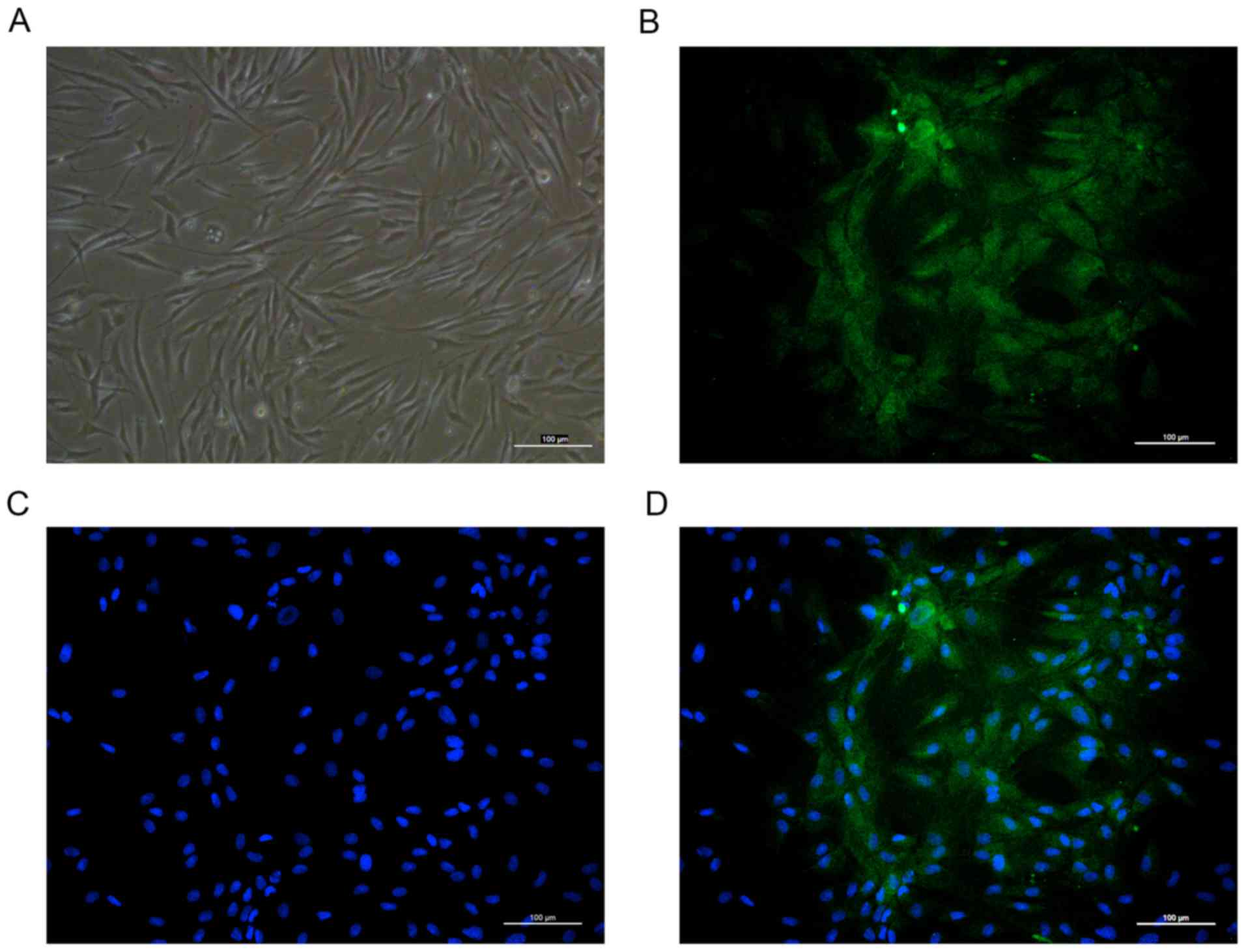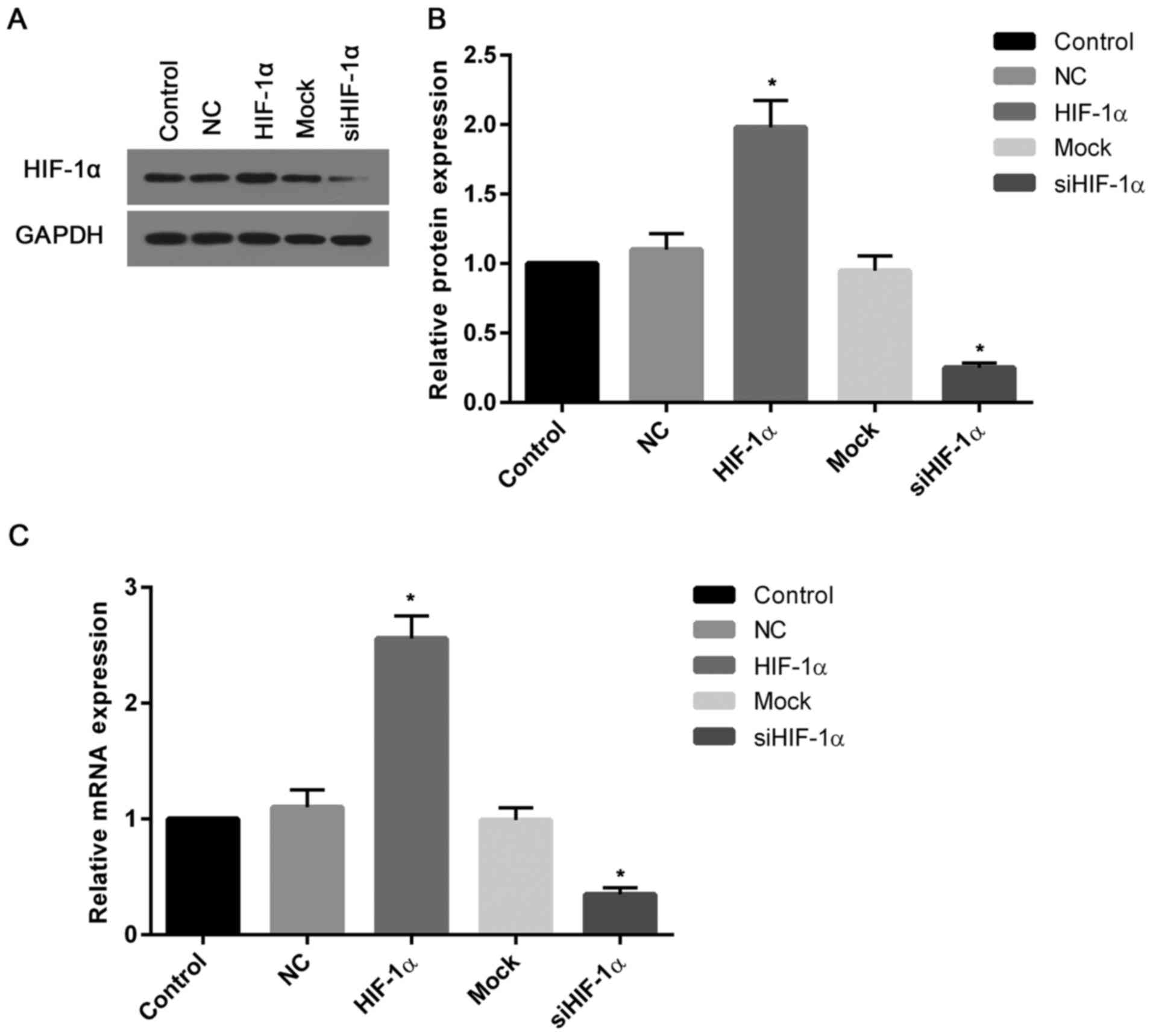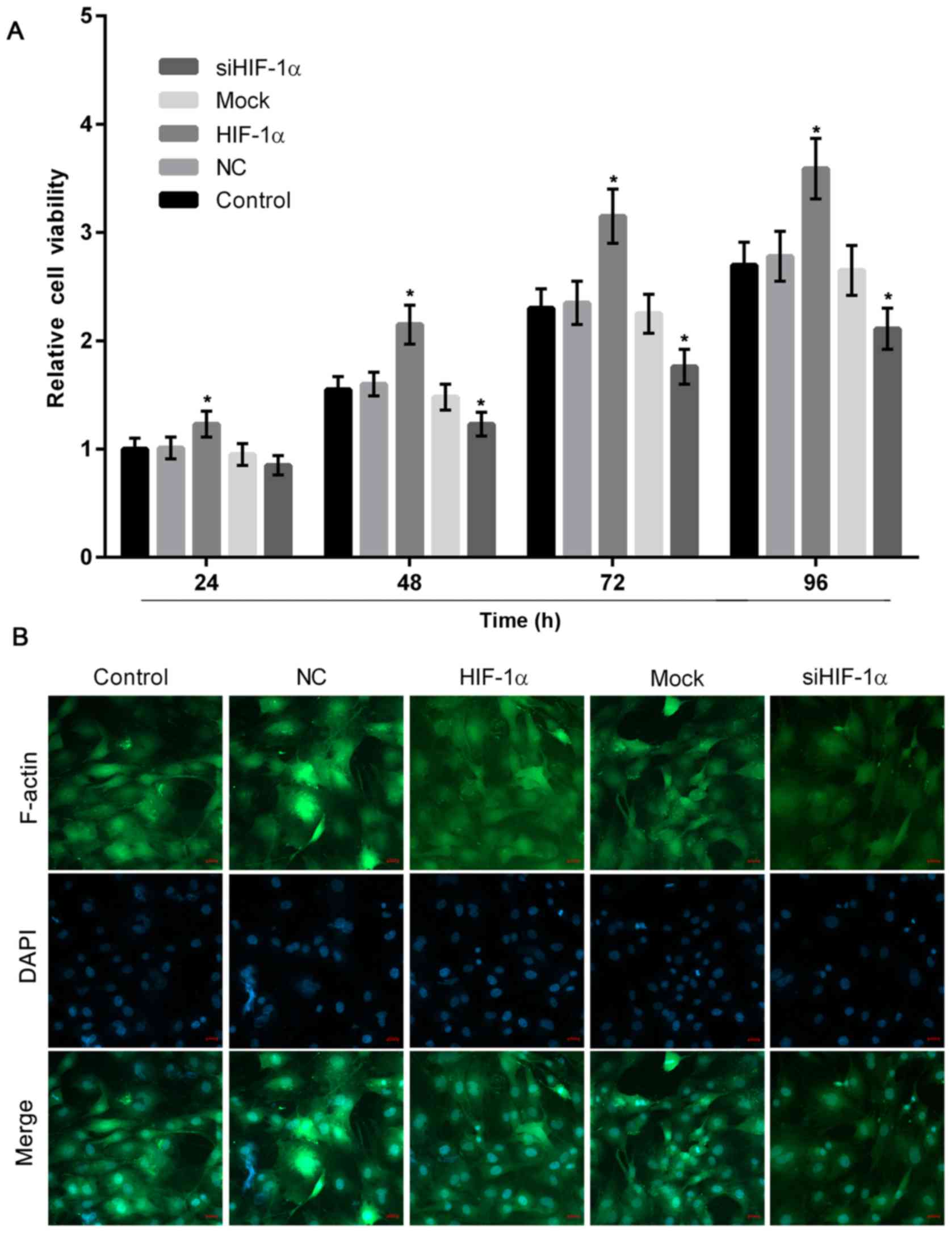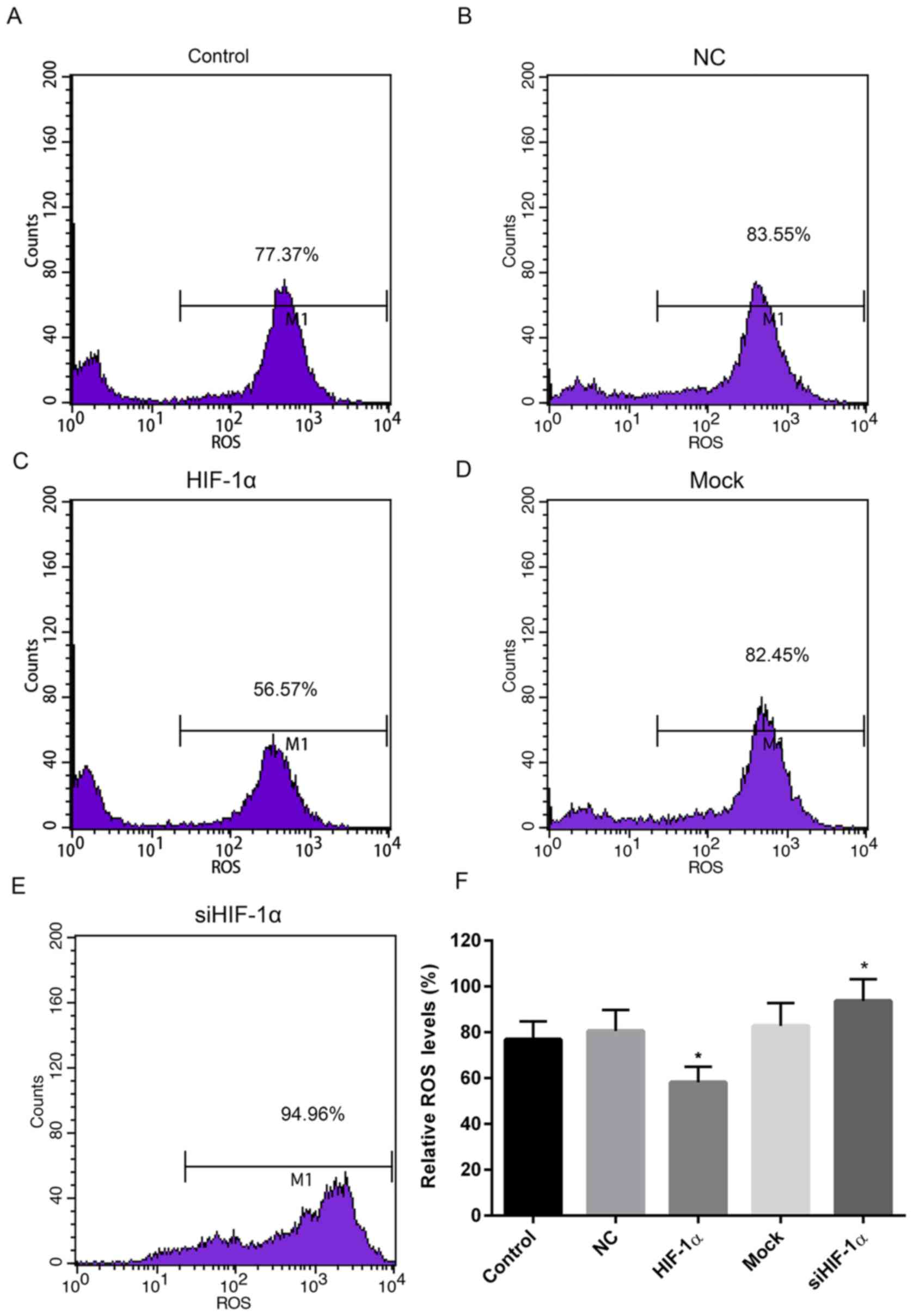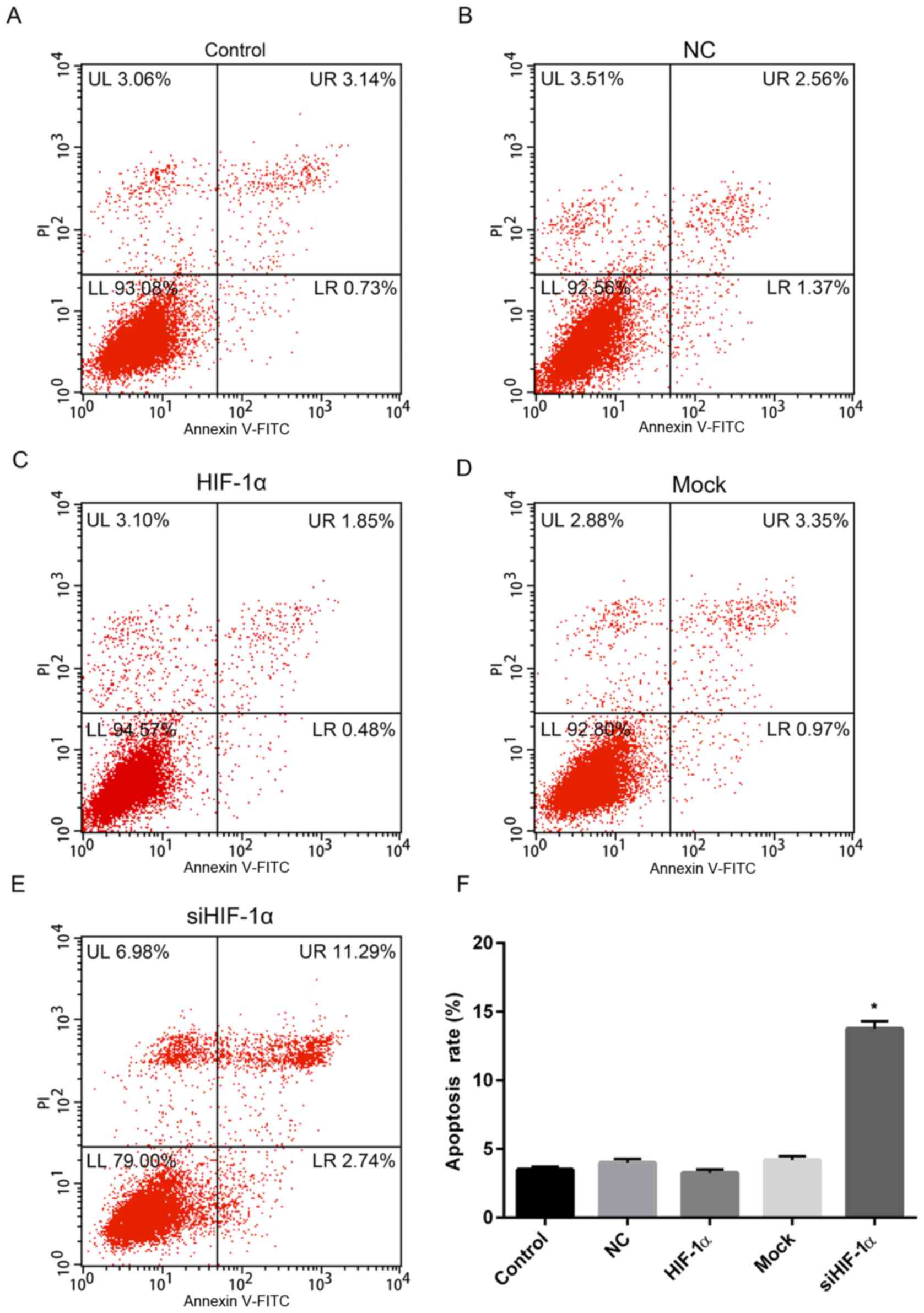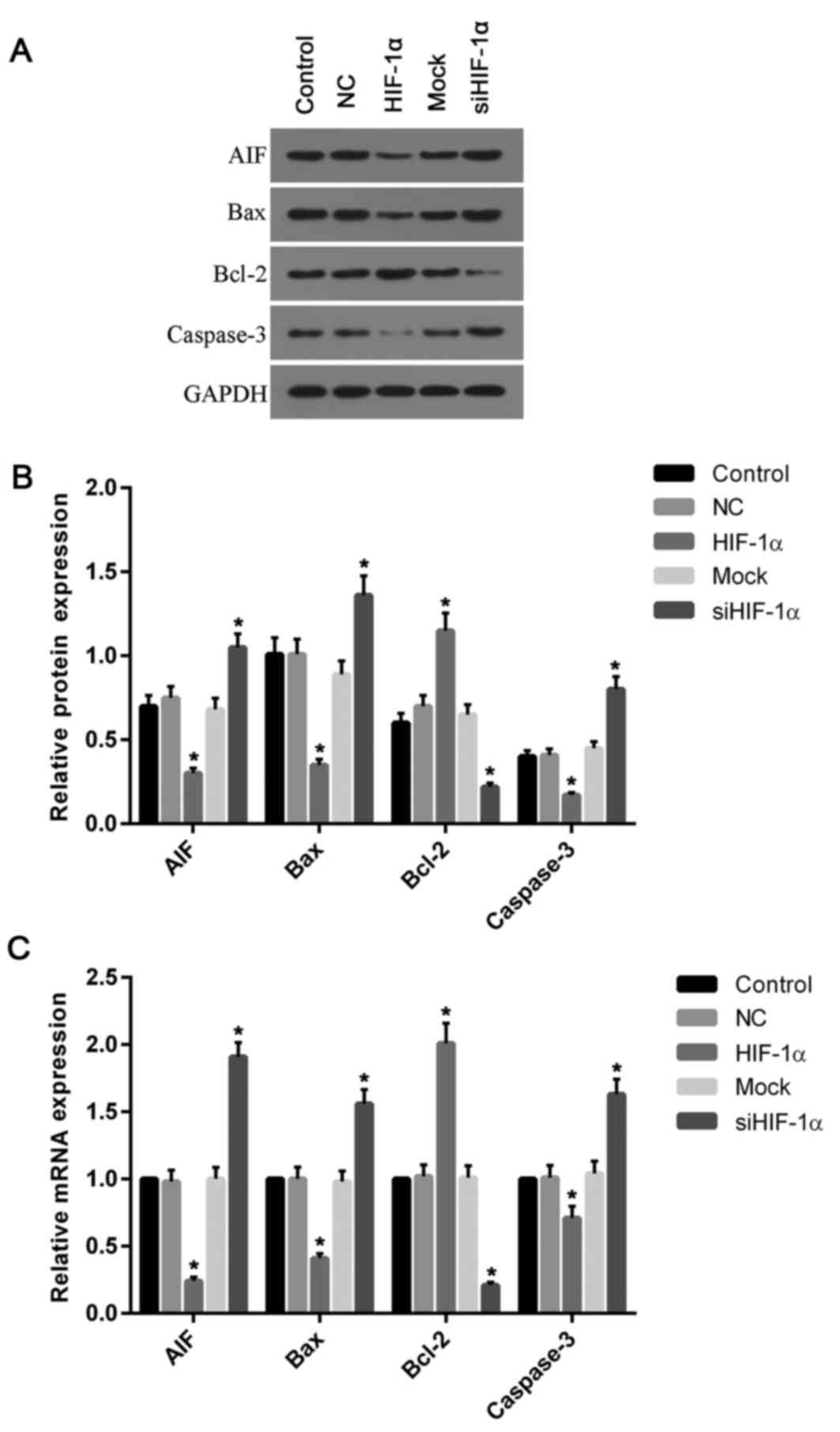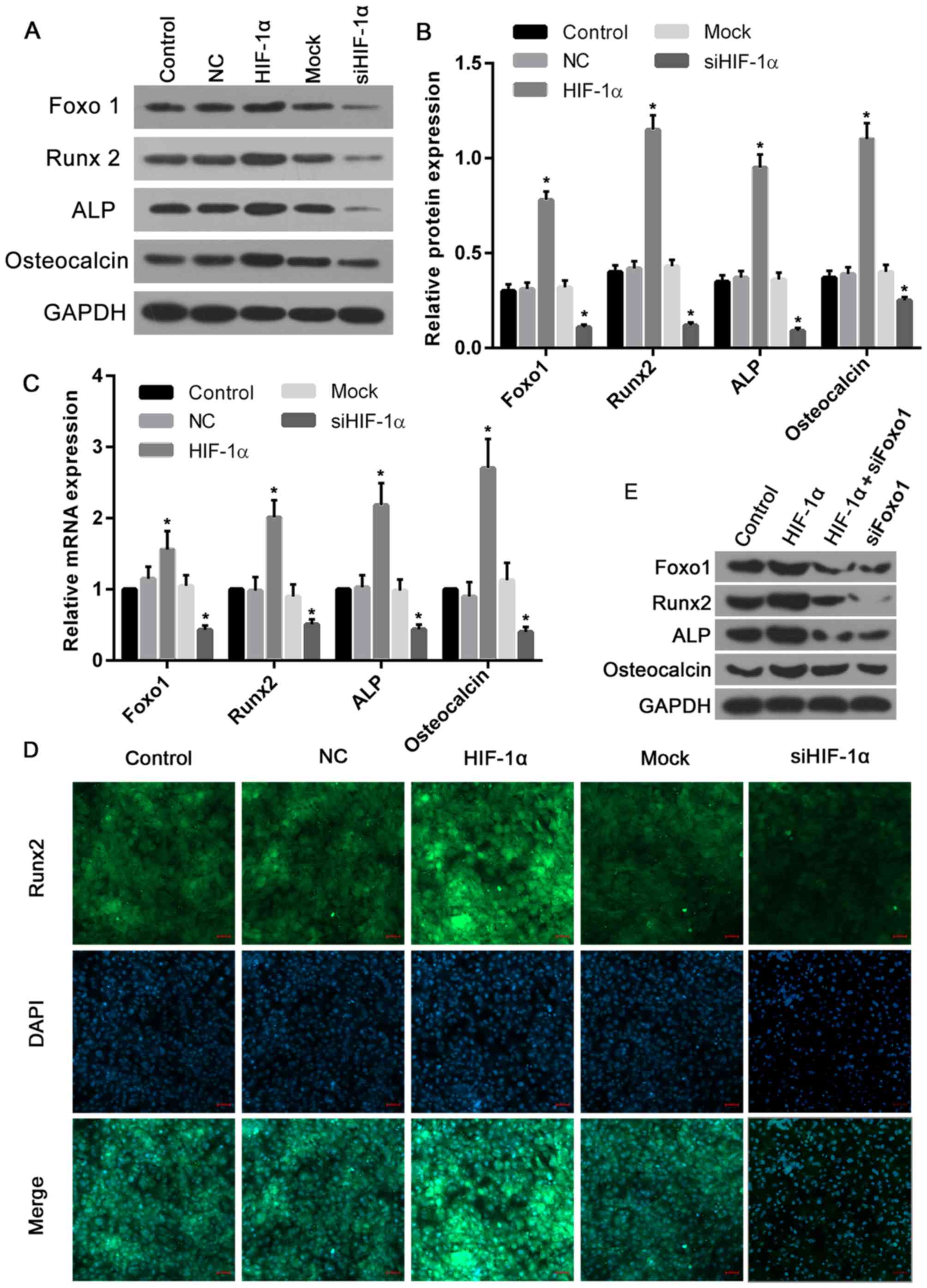HIF-1-mediated expression of Foxo1 serves an important role in the proliferation and apoptosis of osteoblasts derived from children's iliac cancellous bone
- Authors:
- Published online on: March 5, 2018 https://doi.org/10.3892/mmr.2018.8675
- Pages: 6621-6631
Abstract
Introduction
Osteoporosis and fractures are the most common orthopedic diseases in the elderly (1). have been plagued by the delayed healing and nonunion of fractures, bone defects and osteoporosis have become a growing concern for orthopedic clinicians, and the outcome of current clinical treatments are not very satisfactory. Therefore, in order to prevent and reduce the occurrence of osteoporosis and fracture, understanding the mechanisms underlying osteoporosis and fracture healing has become important in research associated with bone injury.
The maintenance of the normal functional state of the body is dependent on an appropriate supply of oxygen. In addition, maintaining homeostasis in regard to oxygen levels is a prerequisite for cell life activity (2), and tissue oxygen concentrations must be precisely controlled to fluctuate only within a very small range (2,3). Due to a reduction in blood supply following bone or soft tissue injury, the microenvironment surrounding lesions enters a hypoxia state (4). Thus, angiogenesis serves an important role in the process of fracture healing (5,6). Osteogenesis is closely associated with angiogenesis in the formation and repair of bone (5–7). Vessels carry oxygen and nutrients; however, they also serve a pivotal role in the formation, reshaping and alteration of bone through interactions between osteoblasts, osteocytes or osteoclasts and cytokines in the blood vessels (5–7). Hypoxia is considered to be an important stimulus in angiogenesis (8); this stimulus is now thought to be achieved by hypoxia inducible factor-1α (HIF-1α) (9). HIF-1α is a key regulator of vertebrate adaptation to hypoxia (9). The study of HIF-1α expression levels, its function and hypoxia status under physiological and pathological conditions in the skeletal system has become an area of growing interest (10,11). There are two main aspects associated with the regulatory function of HIF-1α in fracture healing. The first being that HIF-1α can induce the formation of blood vessels during the healing process of the fracture by stimulating the expression of vascular endothelial growth factor (VEGF) (10,11). Secondly, HIF-1α is directly involved with the regulation of cell functioning, including in osteoblasts, osteoclasts and chondrocytes (10,11). However, the detailed mechanisms of HIF-1α in the proliferation, apoptosis and differentiation of osteoblasts have not been fully elucidated. Previous studies have revealed that blocking expression of runt-related transcription factor 2 (Runx2) and HIF-1α inhibited the formation of heterotopic ossification (11,12). Runx2 can stabilize HIF-1α structure via the inhibition of HIF-1α ubiquitination in order to promote angiogenesis in growth plate hypertrophic chondrocytes (12).
Forkhead box class O1 (Foxo1) is one of the earliest members identified in the Foxo family, and is also the most representative of the Foxo family. Previous studies had demonstrated that they serve an important role in a number of physiological and pathological processes, including proliferation, apoptosis, phagocytosis, metabolism, inflammation, differentiation and oxidative stress (13,14). Previous studies revealed that Foxo1 mediates dendritic cells and macrophages in order to regulate associated target genes in inflammatory responses (15); osteoclasts, dendritic cells and macrophages share a common precursor cell line. However, only Foxo1 is the transcription factor required for osteoblast proliferation and the maintenance of the body's redox balance (16). In addition, previous studies have demonstrated that interactions and cooperation between Foxo1and Runx2 serve a key role in the transcriptional regulation of osteoblast markers, including alkaline phosphatase (ALP), and osteocalcin (17,18). Runx2, ALP and osteocalcin are closely associated with the development of osteoblasts.
In addition, orthopedic diseases in children and adolescents, such as osteoporosis, and children with avascular necrosis and non-traumatic avascular necrosis of the femoral head, have received little attention when compared with orthopedic diseases observed in the elderly (19–21). A previous study revealed that the negative associations between HIF-1α and the rate of bone cell apoptosis was involved in the non-traumatic avascular necrosis of the femoral head (22). Furthermore, there has been no report regarding the associations between HIF-1α and Foxo1. Thus, in the present study, children's iliac cancellous bone was used to determine whether HIF-1α regulates the proliferation, differentiation and apoptosis of osteoblasts through the regulation of Foxo1 expression.
Materials and methods
Cell culture
Bone tissues were obtained between February 2015 and March 2017 from children with congenital dislocation of the hip when they underwent surgery for extra iliac bone at Department of Orthopedics, the Children's Hospital, Zhejiang University School of Medicine. The present study was approved by the institutional review board of The Children's Hospital (Zhejiang, China) and written informed consent was obtained from the parents of each participant. Only children who were not taking hormones or other drugs, and had no metabolic bone disease were enrolled, comprising 2 males and 2 females, aged 3–5 years old. The obtained bone tissues were maintained aseptically, and placed in DMEM/F-12 serum-free medium (DMEM; Sigma-Aldrich, St. Louis, MO, USA) for storage at 4°C. Bone tissues were repeatedly rinsed with 0.9% sterile saline until the rinse solution was clear without any precipitates, and were washed twice with Dulbecco's PBS. The bone tissue was cut to a size with ~1 mm3 volume and digested with 0.25% trypsin at 37°C for 30 min.
Bone particles were then digested 4 times using 0.1% collagenase II at 37°C for 30 min. The cells were collected by centrifugation at 500 × g for 10 min at 4°C. They were inoculated into four 100 ml flasks, DMEM/F-12 serum-free medium (DMEM; Sigma-Aldrich; Merck KGaA, Darmstadt, Germany) was added and the cells were incubated at 37°C in a humidified atmosphere containing 5% CO2. According to levels of the growth, culture medium was replaced in the first 3–5 days, then it was subsequently replaced every 2–3 days. When the primary cells were grown into monolayers, the cells were digested with 0.25% trypsin for 3–5 min at 37°C to continue subculture. In addition to natural purification, enzymatic digestion and repeated adherence methods were used to purify cells (23).
Identification of osteoblasts
The isolated cells were cultured in primary culture, and morphological observation and imaging were performed under an inverted phase contrast microscope when the cells were subcultured to 80% confluence.
Cell osteocalcin immunofluorescence staining was also performed to identify osteoblasts. Osteoblasts were inoculated on coverslips and the medium was discarded when the cells reached 80% confluency; cells were then fixed with 95% ethanol for 10 min. Cell climbing slices were washed with PBS three times for 5 min each, incubated at room temperature with 0.5% Triton X-100 for 10 min, and then washed 3 times with PBS for 5 min each. Subsequently, once the slices were incubated with 5% bovine serum albumin (Sigma-Aldrich; Merck KGaA) for 20 min at room temperature, the anti-osteocalcin antibody (ab13418; 31:100; Abcam, Cambridge, UK) was added for incubation overnight at 4°C; this was followed by 3 washes with PBS for 5 min. The slices were then incubated with a TRITC-labeled secondary antibody (YB1130; 1:50; Dako; Agilent Technologies GmbH, Waldbronn, Germany) for 45 min at room temperature. Subsequently, DAPI staining was performed to stain the nuclei for 15 min at room temperature, which was followed by 3 washes with PBS for 5 min each. Then five fields were randomly selected from each section and observed and imaged under a laser confocal microscope.
Cell transfection
HIF-1α small interfering (si)RNA (5′CCAACCTCAGTGTGGGT-AT3′) and negative siRNA control (5′CCATGTAG-GCGCAGTCTAT3′) were synthesized by Shanghai GenePharma Co., Ltd. (Shanghai, China) and recombinant plasmid containing HIF-1α (Addgene, Inc., Cambridge, MA, USA) were transfected into cells with Lipofectamine 2000® (Invitrogen; Thermo Fisher Scientific, Inc., Waltham, MA, USA). Briefly, prior treatment with siRNA, cells were seeded in 6-well plates and grown to 50% confluence. Transfection of 50 nM siRNA in cells was carried out using Lipofectamine 2000® following the manufacturer's protocols. Cells were then incubated for 5 h at 37°C and the medium was replaced with complete DMEM medium (Sigma-Aldrich; Merck KGaA). Cells were harvested at least 24 h following transfection for use in the following experiments.
Cell viability assay
Cell viability was determined using a Cell Counting kit (CCK)-8 assay. Cells collected at 24, 48, 72 and 96 h following transfection were inoculated in 96-well plates (2×105 cells/well) and 20 µl of CCK-8 (Dojindo Molecular Technologies, Inc., Kumamoto, Japan) was added to each well. Following incubation for 4 h at 37°C, the absorption was read at 450 nm on an ELISA reader (ELx800™; BioTek Instruments, Minneapolis, MN, USA).
Reactive oxygen species (ROS) assay
Cells were harvested from all groups [control, negative control (NC), HIF1a, Mock and siHIF1a] and washed with PBS following transfection for 24 h. Cells were then incubated in 20 µM 2′,7′-Dichorofluorescin diacetate (Sigma-Aldrich; Merck KGaA) at 37°C for 1 h following the manufacturer's protocols. Following washing with PBS, ROS levels in cells were determined using FACS Aria II flow cytometer (BD Biosciences, San Jose, CA, USA) and data analysis was performed using FlowJo version 7.6 (FlowJo LLC, Ashland, OR, USA).
Apoptosis determination by flow cytometry assay
Cells collected from all groups (control, NC, HIF1a, Mock and siHIF1a) were digested using 0.25% trypsin-EDTA for 3–5 min at 37°C. Subsequently, cells were harvested at a density of 1×106 by centrifugation at 500 × g for 4 min at 4°C. Cells were washed with PBS and then placed in binding buffer (140 mM NaCl and 2·5 mM CaCl2 in 10 mM HEPES/NaOH; pH 7·4). A total of 5 µl propidium iodide (PI) and fluorescein isothiocyanate (FITC)-labeled Annexin V (Biodesign International; Meridian Life Science, Inc., Memphis, TN, USA) were added to cells for incubation at room temperature for 10 min. Samples were analyzed by FACS Aria II flow cytometer (BD Biosciences) and data analysis was performed using FlowJo version 7.6 (FlowJo LLC). Those that were Annexin V-FITC positive and PI negative were considered early apoptotic cells, and late apoptotic cells were indicated by Annexin V-FITC positive and PI positive.
Western blot assay
Cells were collected from all groups and washed twice with ice-cold PBS. Cells were then lysed in radioimmunoprecipitation assay lysis buffer (50 mM Tris-HCl, 200 mM NaCl, 1 mM EDTA, 1 mM EGTA, 1% Triton X-100, 0.25% deoxycholate, and protease and phosphatase inhibitors) at 37°C for 30 min and centrifuged for 20 min at 6,000 × g at 4°C. The supernatants were collected and 50 µg of cell lysate was used to separate proteins by 10% SDS-PAGE, which were then transferred onto a nitrocellulose membrane. The membranes were blocked with 5% non-fat dry milk for 1 h at room temperature. Subsequently, the blots were incubated with primary antibodies against apoptosis-inducing factor (AIF; ab32516; 1:1,000; Abcam), B-cell lymphoma 2 (Bcl-2; ab32124; 1:1,000; Abcam), Bcl-2-associated X protein (Bax; ab32503; 1:2,000; Abcam), caspase-3 (ab13585; 1:1,000; Abcam), Runx2 (ab76956; 1:1,000; Abcam), ALP (ab224335; 1:1,000; Abcam), osteocalcin (ab13420; 1:1,000; Abcam), F-actin (ab205; 1:500; Abcam) and Foxo1 (ab207204; 1:1,000; Abcam), at the appropriate dilution at 4°C overnight. The blots were then washed three times with TBS and incubated with horseradish peroxidase-conjugated secondary antibodies (P0260; 1:2,000 dilution; Dako; Agilent Technologies, Inc., Santa Clara, CA, USA) for at room temperature for 1 h. The protein-antibody complexes were detected using an enhanced chemiluminescence system (GE Healthcare Life Sciences, Little Chalfont, UK). ImageJ software (version 1.42; National Institutes of Health, Bethesda, MD, USA) was used to determine densitometry.
Reverse transcription-quantitative polymerase chain reaction (RT-qPCR) assay
Cells collected from all groups were washed twice with ice-cold PBS. RNA was isolated using the RNeasy mini-kit (Qiagen GmbH, Hilden, Germany) following the manufacturer's protocols. Reverse transcription was carried out at with the iScript cDNA synthesis kit (Bio-Rad Laboratories, Inc., Hercules, CA, USA) according to the manufacturer's protocols. The temperature protocol used for RT-PCR was: 30°C for 10 min, 42°C for 30 min, 99°C for 5 min and 4°C for 5 min. Subsequently, qPCR was performed using the iQ SYBR-Green Supermix (Bio-Rad Laboratories, Inc.) and iCycleriQ thermal cycler (Bio-Rad Laboratories, Inc.) following the manufacturer's protocols. The thermocycling conditions for qPCR were: 45°C for 10 min, 95°C for 10 min, 40 cycles of 95°C 15 sec and 60°C for 45 sec. Each sample was performed in duplicate. Data was calculated using the 2−∆∆Cq method (24) and relative expression was normalized to housekeeping gene (GAPDH). The primer sequences used were as follows: HIF-1α forward, 5′-TCCAAGAAGCCCTAACGTGT-3′ and reverse, 5′-TGATCGTCTGGCTGCTGTAA-3′; AIF forward, 5′-TCTACCCTCTATGCCAGGACT-3′ and reverse, 5′-ACCCAGATGTTAGAGCGTGC-3′; Bax forward, 5′-TCATGGGCTGGACACTGGAC-3′ and reverse, 5′-CACAGTCCAAGGCAGTGGGA-3′; Bcl-2 forward, 5′-TGGGCCACAAGTGAAGTCAA-3′ and reverse, 5′-TGATGCGGAAGTCACCGAAA-3′; caspase-3 forward, 5′-TCTGGTTTTCGGTGGGTGTG-3′ and reverse, 5′-GTCGGCCTCCACTGGTATTT-3′; Foxo1 forward, 5′-GCGCTTAGACTGTGACATGG-3′ and reverse, 5′-ACTAACCCTCAGCCTGACAC-3′; Runx2 forward, 5′-CTGTGGTTACTGTCATGGCG-3′ and reverse, 5′-AGGTAGCTACTTGGGGAGGA-3′; ALP forward, 5′-GTCAGTGGGAGTGGTAACCA-3′ and reverse, 5′-ACATGTACTTTCGGCCTCCA-3′; Osteocalcin forward, 5′-AATCCGGACTGTGACGAGTT-3′ and reverse, 5′-TTATTTGGGAGCAGCTGGGA-3′; and GAPDH forward, 5′-CGGGAAACTGTGGCGTGATG-3′, and reverse 5′-ATGACCTTGCCCACAGCCTT-3′.
Statistical analysis
All of the experimental data were expressed as the mean ± standard deviation. A t-test was used for comparisons between two groups and a one-way analysis of variance was performed for multiple comparisons and Bonferroni post hoc test was used for pairwise comparison. All experiments were repeated at least 3 times. SPSS 22.0 software (IBM Corp., Armonk, NY, USA) was used for statistical analysis. P<0.05 was considered to indicate a statistically significant difference.
Results
Identification of osteoblasts by morphology and fluorescence immunity
The primary cultured human osteoblasts were observed under an inverted phase contrast microscope and revealed spherical morphology prior to adherent growth. Following incubation, the cells adhered and distributed evenly on the wall of the bottle. The cells were irregularly shaped, with long fusiform, star or irregular polygons. The cytoplasm was homogeneous and the central nucleus was round, oval centered or biased (Fig. 1A). To further confirm the osteoblasts obtained, the present study performed immunofluorescence staining of osteocalcin and osteoblasts were observed to exhibit intense cytoplasmic staining for osteocalcin (Fig. 1B-D).
Expression of HIF-1α at the protein and mRNA levels
To assess the transfection efficiency, the present study determined the transcriptional and translational levels of HIF-1α in cells. The western blotting and mRNA assays demonstrated that the levels of HIF-1α protein and mRNA in cells transfected with recombinant HIF-1α were ~2 and 2.5-fold greater than that of the control (Fig. 2A and B). However, the expression of HIF-1α protein and mRNA in cells treated with HIF-1α siRNA were markedly suppressed when compared with the control (Fig. 2C).
HIF-1α overexpression or knockdown induces or suppresses the proliferation of osteoblasts
To evaluate the effect of differentiated HIF-1α expression in osteoblasts, the present study performed a CCK-8 assay, which revealed that HIF-1α overexpression significantly stimulated osteoblast proliferation, while downregulation of HIF-1α significantly decreased the growth of osteoblasts when compared with the control (Fig. 3A). Furthermore, in the HIF-1α overexpression group, F-actin positive immunofluorescence staining was greater and osteoblast proliferation was higher, when compared with the group with HIF-1α downregulation (Fig. 3B).
ROS levels increase in cells with HIF-1α downregulation
To measure the levels of oxidative stress in cells up- or downregulated HIF-1α, the ROS levels were determined. When compared with the control and NC groups, the relative ROS level in cells treated with recombinant HIF-1α was markedly reduced. By contrast, the relative ROS level in cells treated with HIF-1α siRNA was elevated when compared with the control and mock groups (Fig. 4).
Overexpression or downregulation of HIF-1α suppresses or stimulates apoptosis, respectively
The effect of overexpression or downregulation of HIF-1α on apoptosis was investigated and the results revealed that the apoptosis rate of cells with HIF-1α overexpression was 2.33%, which was slightly lower than that of the control (3.87%) and NC (3.93%) groups (Fig. 5A-C and F). However, the rate of apoptosis for cells treated with HIF-1α siRNA was 14.03%, which was significantly higher than that of control and mock (4.32%) groups (Fig. 5D-F).
Up- or downregulated HIF-1α alters the expression of apoptosis-associated genes
To investigate the effect of HIF-1α on the expression of genes associated with apoptosis, the present study further detected the expression of AIF, Bax, Bcl-2 and caspase-3. The expression levels of AIF, Bax and caspase-3 mRNA and protein decreased in cells with overexpressed HIF-1α, compared with the control and NC groups (Fig. 6). By contrast, they were increased in cells with downregulated HIF-1α, when compared with the control and mock groups. However, unlike Bax, the Bcl-2 mRNA and protein levels were increased in cells treated with recombinant HIF-1α and decreased in cells treated with HIF-1α siRNA when compared with the control (Fig. 6).
Overexpression or down-regulation of HIF-1α increases or decreases the expression of Foxo1 and osteoblast markers
To explore the function of HIF-1α in the regulation of the expression of Foxo1 and osteoblast markers including Runx2, ALP and osteocalcin, the present study determined their expression following the upregulation or silencing of HIF-1α. The results demonstrated that the protein levels of Foxo1, Runx2, ALP and osteocalcin were significantly elevated in cells treated with recombinant HIF-1α when compared with those of the control and NC groups (Fig. 7A and B). However, in cells treated with HIF-1α siRNA, the protein levels of Foxo1, Runx2, ALP and osteocalcin were markedly decreased compared with the control and mock groups (Fig. 7A and B). Similarly, the mRNA expression levels of Foxo1, Runx2, ALP and osteocalcin in cells overexpressing HIF-1α were ~1.5, 2, 2.2 and 2.7-fold greater of that of the control and NC groups, respectively. Furthermore, the expression levels of Foxo1, Runx2, ALP and osteocalcin mRNA in cells treated with HIF-1α siRNA were significantly suppressed when compared with the control and mock groups (Fig. 7C). To further confirm these altered osteoblast marker expressions, the expression of the osteogenic marker Runx2 was evaluated by immunofluorescence and the greatest Runx2 expression levels were observed in the HIF-1α overexpression group, while the lowest levels were seen in cells with HIF-1α silencing (Fig. 7D). In addition, to confirm the role of Foxo1 in HIF-1α-induced osteoblast proliferation, further blotting experiments were performed. The results revealed that Runx2 and ALP expression induced by HIF-1α were markedly reversed by Foxo1 siRNA, while osteocalcin was not affected by Foxo1 siRNA (Fig. 7E). Thus, it was proposed that HIF-1α-induced expression of Runx2 and ALP may be completely dependent on the expression levels of Foxo1, and in turn, osteocalcin may be partially dependent on Foxo1, though to a much lesser degree.
Discussion
HIF-1α serves a pivotal role in the stimulation of bone formation via the regulation of several key factors such as Runx2 (12). The Foxo subfamily regulates the expression of genes associated with a variety of physiological and pathological processes (14); however, they also have a role in the proliferation, differentiation and apoptosis of osteoblasts, which to date has been quite well studied. Previous studies have demonstrated that Foxo1 can stimulate the growth of osteoblasts by increasing the expression of Runx2 (17). Therefore, the present study investigated whether HIF-1α affects the expression of Runx2 by regulating Foxo1. The results revealed that the interactions between HIF-1α and Foxo1 serve a key role in the proliferation, differentiation and apoptosis of osteoblasts.
HIF-1α is an important transcription factor involved in cell metabolism, with roles such as promoting glycolysis and inhibiting mitochondrial respiration (25). HIF-1α upregulates pyruvate dehydrogenase kinase, inhibits pyruvate dehydrogenase activity and blocks pyruvate entry into tricarboxylic acid (TCA) cycle, thereby inhibiting mitochondrial oxidative phosphorylation (25–27). As mitochondrial respiration is the primary source of ROS, it was hypothesized that HIF-1α may reduce ROS production. The results demonstrated that ROS levels were decreased in cells with overexpressed HIF-1α, which is consistent with the authors' hypothesis. In addition, ROS levels were markedly increased in cells treated with HIF-1α siRNA compared with normal osteoblasts. These results suggested that the underlying mechanism may involve the suppression effect of HIF-1α on ROS in osteoblasts.
In the process of bone development and regeneration, angiogenesis is closely associated with bone neoplasm (28). Previous studies had observed that HIF-1α can promote the proliferation and migration of vascular endothelial cells, and increase the permeability of vascular endothelial cells (29,30), which provides nutrition for the growth of cells and the establishment of capillaries, and also promotes the development of bone marrow-derived endothelial progenitor cells that transfer to the site of hypoxic injury (30,31). Thus, the present study measured the cell viabilities and rates of apoptosis in osteoblasts with HIF-1α overexpression or knockdown. The results revealed that the cell viabilities and proliferation were increased in cells with overexpression, and decreased in cells with downregulated HIF-1α. Furthermore, apoptosis was significantly increased in cells with silenced HIF-1α; however, the apoptosis rate in cells with overexpressed HIF-1α was marginally decreased compared with normal cells. Consistent with these results, the expression levels of the proapoptotic genes AIF, Bax and caspase-3 were increased, while the anti-apoptotic gene Bcl-2 was decreased in cells treated with HIF-1α siRNA. These results and those of previous reports indicate that the inhibition of HIF-1α function suppresses osteoblast proliferation (12).
The Foxo family mainly includes Foxo1, Foxo3 and Foxo4, and is a group comprised of multifunctional transcription factors involved in the cell cycle, apoptosis and ROS metabolism (14). In addition, previous investigations revealed that Foxo1 is closely associated with the proliferation, differentiation and apoptosis of osteoblasts (16,18,32,33). Therefore, the present study detected the expression levels of Foxo1 in order to determine the associations between HIF-1α and Foxo1. The transcriptional and translational levels of Foxo1 were increased in cells with HIF-1α overexpression. Previous studies have demonstrated that Foxo1 can upregulate the ROS reducing agent manganese peroxidase, Catalase and sestrin 3, which produce superoxide oxidation, antioxidant protein (overoxidized peroxiredoxins) degradation of ROS (34,35). Therefore, it was assumed in the present study that the increased ROS levels in cells with HIF-1α silencing were associated with the downregulation of Foxo1 induced by knockdown HIF-1α. Notably, the complete knockdown of Foxo1 in vivo has previously been observed to induce the incomplete development of the embryonic vascular system, which in turn leads to the apoptosis of embryonic cells and thus, the termination of the pregnancy (36). Furthermore, Foxo1 serves a pivotal protective role in endoplasmic reticulum stress-, hypoxia- and tumor necrosis factor-induced apoptosis in a variety of cell lines (37–39). Therefore, the interactions between HIF-1α and Foxo1 may be an important factor for the regulation of osteoblast apoptosis.
To date, HIF-1 has been associated with the regulation of a variety of genes including VEGF, bone morphogenetic protein and osteocalcin, which in turn are closely associated with angiogenesis and bone formation (30,31). Several studies have reported that the deletion of HIF-1α results in the downregulation of osteoblast markers, including Runx2, ALP and osteocalcin (12,40,41). However, the mechanism by which HIF-1α regulates these genes remains unclear. In addition, a number of investigations have revealed that knockout of Foxo1 markedly reduced the expression of Runx2, ALP and osteocalcin, resulting in the reduction of culture calcification even with exposure to osteogenic stimulants (17,19,32). Thus, it was hypothesized in the present study that there may be a close association between HIF-1α and Foxo1 in the regulation of the expression of these genes. Therefore, the expression of these genes was further investigated. The results revealed that Runx2 and ALP expression induced by HIF1α were markedly reduced by Foxo1 siRNA; however, osteocalcin was not notably affected by Foxo1 siRNA. It is therefore a possibility that the HIF1α-induced expression of Runx2 and ALP may be completely dependent upon the expression levels of Foxo1, and osteocalcin may be partially dependent on Foxo1. The results of the present study were consistent with the authors' hypothesis and with the results of previous studies (17,18,32). Notably, the mRNA and protein levels of Runx2, ALP and osteocalcin had similar expression profiles as those of HIF-1α and Foxo1. Silencing HIF-1α resulted in the decreased expression of Runx2, ALP and osteocalcin, while overexpression of HIF-1α led to an increased expression of Runx2, ALP and osteocalcin. The accumulation of HIF-1α protein has been associated with Runx2 in ATDC5 chondrocytes and HEK293 cells (42). In addition, Runx2 can promote the nuclear translocation of HIF-1α in HEK293 cells (42). Runx2 can also stabilize the structure of HIF-1α by suppressing the ubiquitination of HIF-1α (40,42). In fact, there are only two specific transcripts in osteoblasts, one encoding Runx2 and the other encoding osteocalcin, in which osteocalcin is an inhibitor of osteoclast function and is expressed only when osteoblasts are completely differentiated (43,44). Furthermore, Runx2 is required for the expression of osteoblast-specific proteins such as osteocalcin (44). Through the regulation of osteocalcin expression, Runx2 can promote bone formation in differentiated osteoblasts (45).
In conclusion, the results of the present study indicated that the dependent activation of Foxo1 by HIF-1α may be essential for osteoblast cell survival, differentiation and proliferation. The increased viabilities of osteoblasts derived from children's iliac cancellous bone with elevated HIF-1α and Foxo1 levels provides evidence for novel approaches that stimulate the development of osteoblasts by activating HIF-1α and Foxo1 in combination.
Acknowledgements
Not applicable.
Funding
No funding was received.
Availability of data and materials
All data generated or analyzed during this study are included in this published article.
Authors' contributions
GX performed the experiments and wrote and revised the manuscript.
Ethics approval and consent to participate
The present study was approved by the institutional review board of The Children's Hospital (Zhejiang, China).
Consent for publication
Written informed consent was obtained from the parents of each participant.
Competing interests
The author declares that he has no competing interests.
References
|
Moradi R and Atik OS: Are orthopedic surgeons more aware of medical treatment of osteoporotic fractures in the last decade? Eklem Hastalik Cerrahisi. 25:80–84. 2014.(In Turkish). View Article : Google Scholar : PubMed/NCBI | |
|
Zheng L, Kelly CJ and Colgan SP: Physiologic hypoxia and oxygen homeostasis in the healthy intestine. A review in the theme: Cellular responses to hypoxia. Am J Physiol Cell Physiol. 309:C350–C360. 2015. View Article : Google Scholar : PubMed/NCBI | |
|
Iranon NN and Miller DL: Interactions between oxygen homeostasis, food availability, and hydrogen sulfide signaling. Front Genet. 3:2572012. View Article : Google Scholar : PubMed/NCBI | |
|
Atkinson PJ, Cooper TG, Anseth S, Walter NE, Kargus R and Haut RC: Association of knee bone bruise frequency with time postinjury and type of soft tissue injury. Orthopedics. 31:4402008. View Article : Google Scholar : PubMed/NCBI | |
|
Murata K, Ito H, Yoshitomi H, Yamamoto K, Fukuda A, Yoshikawa J, Furu M, Ishikawa M, Shibuya H and Matsuda S: Inhibition of miR-92a enhances fracture healing via promoting angiogenesis in a model of stabilized fracture in young mice. J Bone Miner Res. 29:316–326. 2014. View Article : Google Scholar : PubMed/NCBI | |
|
Fauzi A, Kamal AF, Kurniawan A and Kodrat E: Role of sildenafil in acceleration of delayed union fracture healing on Sprague-Dawley rats model. Br J Med Med Res. 8:419–428. 2015. View Article : Google Scholar | |
|
Fang TD, Salim A, Xia W, Nacamuli RP, Guccione S, Song HM, Carano RA, Filvaroff EH, Bednarski MD, Giaccia AJ and Longaker MT: Angiogenesis is required for successful bone induction during distraction osteogenesis. J Bone Miner Res. 20:1114–1124. 2005. View Article : Google Scholar : PubMed/NCBI | |
|
Molica S, Vitelli G, Levato D, Gandolfo GM and Liso V: Increased serum levels of vascular endothelial growth factor predict risk of progression in early B-cell chronic lymphocytic leukaemia. Br J Haematol. 107:605–610. 1999. View Article : Google Scholar : PubMed/NCBI | |
|
Benita Y, Kikuchi H, Smith AD, Zhang MQ, Chung DC and Xavier RJ: An integrative genomics approach identifies Hypoxia inducible factor-1 (HIF-1)-target genes that form the core response to hypoxia. Nucleic Acids Res. 37:4587–4602. 2009. View Article : Google Scholar : PubMed/NCBI | |
|
Chen D, Tian W, Li Y, Tang W and Zhang C: Osteoblast-specific transcription factor Osterix (Osx) and HIF-1α cooperatively regulate gene expression of vascular endothelial growth factor (VEGF). Biochem Biophys Res Commun. 424:176–181. 2012. View Article : Google Scholar : PubMed/NCBI | |
|
Lechler P, Klein SM, Prantl L, Englert C, Renkawitz T and Grifka J: Hypoxic downregulation of cellular proliferation and loss of phenotype stability in human osteoblasts is mediated by HIF-1α. Clin Hemorheol Microcirc. 49:279–286. 2011.PubMed/NCBI | |
|
Lin L, Shen Q, Leng H, Duan X, Fu X and Yu C: Synergistic inhibition of endochondral bone formation by silencing Hif1α and Runx2 in trauma-induced heterotopic ossification. Mol Ther. 19:1426–1432. 2011. View Article : Google Scholar : PubMed/NCBI | |
|
Kim HS, Nam JS, Le SS, Kim LS, Ryu BY, Kang HJ, Choi BS, Ganbold B and Ko YC: Abstract 564: Foxo3a regulates cell cycle arrest through the regulation of p53, p21 and GADD45 signaling activity in Quercetin-treated MDA-MB-231 breast cancer cells. Cancer Res. 73:5642013. View Article : Google Scholar | |
|
Lu H and Huang H: FOXO1: A potential target for human diseases. Curr Drug Targets. 12:1235–1244. 2011. View Article : Google Scholar : PubMed/NCBI | |
|
Brown J, Wang H, Suttles J, Graves DT and Martin M: Mammalian target of rapamycin complex 2 (mTORC2) negatively regulates toll-like receptor 4-mediated inflammatory response via FoxO1. J Biol Chem. 286:44295–44305. 2011. View Article : Google Scholar : PubMed/NCBI | |
|
Kim KM, Park SJ, Jung SH, Kim EJ, Jogeswar G, Ajita J, Rhee Y, Kim CH and Lim SK: miR-182 is a negative regulator of osteoblast proliferation, differentiation, and skeletogenesis through targeting FoxO1. J Bone Miner Res. 27:1669–1679. 2012. View Article : Google Scholar : PubMed/NCBI | |
|
Yang S, Xu H, Yu S, Cao H, Fan J, Ge C, Fransceschi RT, Dong HH and Xiao G: Foxo1 mediates insulin-like growth factor 1 (IGF1)/insulin regulation of osteocalcin expression by antagonizing Runx2 in osteoblasts. J Biol Chem. 286:19149–19158. 2011. View Article : Google Scholar : PubMed/NCBI | |
|
Teixeira CC, Liu Y, Thant LM, Pang J, Palmer G and Alikhani M: Foxo1, a novel regulator of osteoblast differentiation and skeletogenesis. J Biol Chem. 285:31055–31065. 2010. View Article : Google Scholar : PubMed/NCBI | |
|
Kubat O, Šmigovec I, Đapić T and Antičević D: Cystic-like lesions of proximal femur associated with fractures in children and adolescents-diagnostic and therapeutic dilemma. J. 2012. | |
|
Madadi F, Shamsian BS, Alavi S, Madadi F, Eajazi A and Aslani A: Avascular necrosis of the femoral head in children with acute lymphoblastic leukemia: A 4- to 9-year follow-up study. Orthopedics. 34:e593–e597. 2011.PubMed/NCBI | |
|
Canale ST: Fracture of hip in children and adolescents. Orthop Clin North Am. 21:341–352. 1990.PubMed/NCBI | |
|
Karatoprak O, Korkmaz MF, Kara AN, Göğüş A and Işiklar ZU: Early results of autologous mononuclear bone marrow cell implantation in nontraumatic avascular necrosis of the femoral head. Acta Orthop Traumatol Turc. 42:178–183. 2008. View Article : Google Scholar : PubMed/NCBI | |
|
Siggelkow H, Rebenstorff K, Kurre W, Niedhart C, Engel I, Schulz H, Atkinson MJ and Hüfner M: Development of the osteoblast phenotype in primary human osteoblasts in culture: Comparison with rat calvarial cells in osteoblast differentiation. J Cell Biochem. 75:22–35. 1999. View Article : Google Scholar : PubMed/NCBI | |
|
Livak KJ and Schmittgen TD: Analysis of relative gene expression data using real-time quantitative PCR and the 2(-Delta Delta C(T)) method. Methods. 25:402–408. 2001. View Article : Google Scholar : PubMed/NCBI | |
|
Bel Aiba RS, Dimova EY, Görlach A and Kietzmann T: The role of hypoxia inducible factor-1 in cell metabolism-a possible target in cancer therapy. Expert Opin Ther Targets. 10:583–599. 2006. View Article : Google Scholar : PubMed/NCBI | |
|
Sudarshan S, Sourbier C, Kong HS, Block K, Valera Romero VA, Yang Y, Galindo C, Mollapour M, Scroggins B, Goode N, et al: Fumarate hydratase deficiency in renal cancer induces glycolytic addiction and hypoxia-inducible transcription factor 1alpha stabilization by glucose-dependent generation of reactive oxygen species. Mol Cell Biol. 29:4080–4090. 2009. View Article : Google Scholar : PubMed/NCBI | |
|
Lu CW, Lin SC, Chen KF, Lai YY and Tsai SJ: Induction of pyruvate dehydrogenase kinase-3 by hypoxia-inducible factor-1 promotes metabolic switch and drug resistance. J Biol Chem. 283:28106–28114. 2008. View Article : Google Scholar : PubMed/NCBI | |
|
Dai J and Rabie AB: VEGF: An essential mediator of both angiogenesis and endochondral ossification. J Dent Res. 86:937–950. 2007. View Article : Google Scholar : PubMed/NCBI | |
|
Kim CH, Kin JK and Yoon JH: Dendritic epidermal T cells promote wound healing by production of vascular endothelial growth factor mediated by HIF-1a signaling. Am J Respir Crit Care Med. 185:A42722012. View Article : Google Scholar | |
|
Kiani AA, Kazemi A, Halabian R, Mohammadipour M, Jahanian-Najafabadi A and Roudkenar MH: HIF-1α confers resistance to induced stress in bone marrow-derived mesenchymal stem cells. Arch Med Res. 44:185–193. 2013. View Article : Google Scholar : PubMed/NCBI | |
|
Jiang C, Sun J, Dai Y, Cao P, Zhang L, Peng S, Zhou Y, Li G, Tang J and Xiang J: HIF-1A and C/EBPs transcriptionally regulate adipogenic differentiation of bone marrow-derived MSCs in hypoxia. Stem Cell Res Ther. 6:212015. View Article : Google Scholar : PubMed/NCBI | |
|
Siqueira MF, Flowers S, Bhattacharya R, Faibish D, Behl Y, Kotton DN, Gerstenfeld L, Moran E and Graves DT: FOXO1 modulates osteoblast differentiation. Bone. 48:1043–1051. 2011. View Article : Google Scholar : PubMed/NCBI | |
|
Moriishi T, Kawai Y, Komori H, Rokutanda S, Eguchi Y, Tsujimoto Y, Asahina I and Komori T: Bcl2 deficiency activates FoxO through Akt inactivation and accelerates osteoblast differentiation. PLoS One. 9:e866292014. View Article : Google Scholar : PubMed/NCBI | |
|
Alikhani M, Maclellan CM, Raptis M, Vora S, Trackman PC and Graves DT: Advanced glycation end products induce apoptosis in fibroblasts through activation of ROS, MAP kinases, and the FOXO1 transcription factor. Am J Physiol Cell Physiol. 292:C850–C856. 2007. View Article : Google Scholar : PubMed/NCBI | |
|
Chen CC, Jeon SM, Bhaskar PT, Nogueira V, Sundararajan D, Tonic I, Park Y and Hay N: FoxOs inhibit mTORC1 and activate Akt by inducing the expression of sestrin3 and rictor. Dev Cell. 18:592–604. 2010. View Article : Google Scholar : PubMed/NCBI | |
|
Hosaka T, Biggs WH III, Tieu D, Boyer AD, Varki NM, Cavenee WK and Arden KC: Disruption of forkhead transcription factor (FOXO) family members in mice reveals their functional diversification. Proc Natl Acad Sci USA. 101:pp. 2975–2980. 2004; View Article : Google Scholar : PubMed/NCBI | |
|
Shen B, Chao L and Chao J: Pivotal role of JNK-dependent FOXO1 activation in downregulation of kallistatin expression by oxidative stress. Am J Physiol Heart Circ Physiol. 298:H1048–H1054. 2010. View Article : Google Scholar : PubMed/NCBI | |
|
Martinez S, Tanabe KM, Cras-Méneur C, Abumrad NA, Bernal-Mizrachi E and Permutt M: Inhibition of Foxo1 protects pancreatic islet beta-cells against fatty acid and endoplasmic reticulum stress-induced apoptosis. Diabetes. 57:846–859. 2008. View Article : Google Scholar : PubMed/NCBI | |
|
Alikhani M, Alikhani Z and Graves DT: FOXO1 functions as a master switch that regulates gene expression necessary for tumor necrosis factor-induced fibroblast apoptosis. J Biol Chem. 280:12096–12102. 2005. View Article : Google Scholar : PubMed/NCBI | |
|
Kwon TG, Zhao X, Yang Q, Li Y, Ge C, Zhao G and Franceschi RT: Physical and functional interactions between Runx2 and HIF-1α induce vascular endothelial growth factor gene expression. J Cell Biochem. 112:3582–3593. 2011. View Article : Google Scholar : PubMed/NCBI | |
|
Hirata M, Kugimiya F, Fukai A, Saito T, Yano F, Ikeda T, Mabuchi A, Sapkota BR, Akune T, Nishida N, et al: C/EBPβ and RUNX2 cooperate to degrade cartilage with MMP-13 as the target and HIF-2α as the inducer in chondrocytes. Hum Mol Genet. 21:1111–1123. 2012. View Article : Google Scholar : PubMed/NCBI | |
|
Lee SH, Che X, Jeong JH, Choi JY, Lee YJ, Lee YH, Bae SC and Lee YM: Runx2 protein stabilizes hypoxia-inducible factor-1α through competition with von Hippel-Lindau protein (pVHL) and stimulates angiogenesis in growth plate hypertrophic chondrocytes. J Biol Chem. 287:14760–14771. 2012. View Article : Google Scholar : PubMed/NCBI | |
|
Sierra J, Villagra A, Paredes R, Cruzat F, Gutierrez S, Javed A, Arriagada G, Olate J, Imschenetzky M, Van Wijnen AJ, et al: Regulation of the bone-specific osteocalcin gene by p300 requires Runx2/Cbfa1 and the vitamin D3 receptor but not p300 intrinsic histone acetyltransferase activity. Mol Cell Biol. 23:3339–3351. 2003. View Article : Google Scholar : PubMed/NCBI | |
|
Xiao G, Jiang D, Ge C, Zhao Z, Lai Y, Boules H, Phimphilai M, Yang X, Karsenty G and Franceschi RT: Cooperative interactions between activating transcription factor 4 and Runx2/Cbfa1 stimulate osteoblast-specific osteocalcin gene expression. J Biol Chem. 280:30689–30696. 2005. View Article : Google Scholar : PubMed/NCBI | |
|
Komori T: Regulation of osteoblast differentiation by Runx2. Adv Exp Med Biol. 658:43–49. 2010. View Article : Google Scholar : PubMed/NCBI |



